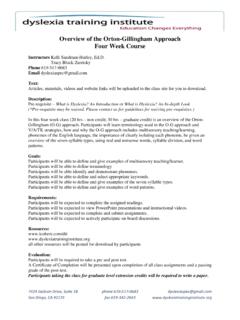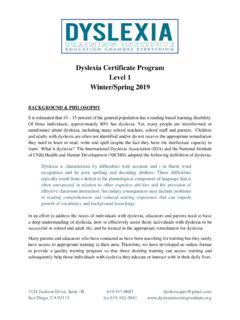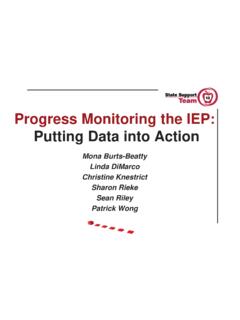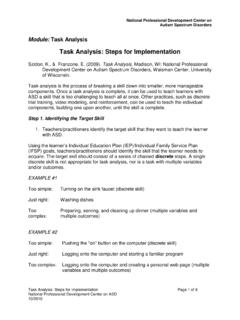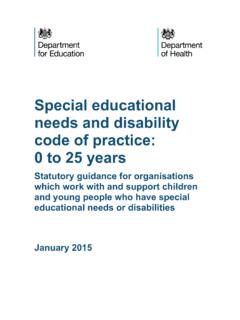Transcription of Dyslexia: How to Write Goals Dr. Kelli Sandman-Hurley ...
1 Dyslexia: How to Write Goals Dr. Kelli Sandman-Hurley Dyslexia Training Institute I am noticing a disturbing trend when I read IEPs and I have had some nonsensical conversations about reading with IEP teams lately as well. This trend and these conversations center around the Goals section of the iep . What this has revealed to me is what I have suspected all along there is a lack of expertise and understanding of not only dyslexia, but the progression of teaching reading and the components of the reading process. To correct this trend I offer the following examples to illustrate some fallacies about reading as well as how to fix Goals . Parents have asked me, how important are the Goals anyway? Remember: needs drive Goals and Goals drive services. The school is only held responsible for the Goals that are set and agreed upon in the iep .
2 If they are low or incorrect and the iep is signed, the school is only responsible for those Goals . It seems to make more sense to make sure the Goals are written so that the child receives some educational benefit and that the Goals make pedagogical sense. For example, if there is a need for fluency improvement then there should be a goal for that. Is there is a need for spelling, there should be a goal for that. If there is a need for sight word improvement, then there should be a goal for that. If there are ten needs, then there are ten Goals . There is no limit to the number of Goals an IEP can have. IEP Team: We did not include a fluency goal because he is only reading 12 words per minute correctly right now, so what is the point in teaching fluency? For those of you who have read my prior articles, you can just insert a snarky comment here.
3 I. will only say, really? I have to admit, I was speechless while I gathered my thoughts to respond. When reading improvement is a need, the iep should always include a fluency goal. Fluency is the ultimate goal of reading and needs to be taught and practiced from day one. Make sure the baseline has a present WPM, not just a grade level. The goal WPM should be high enough that it would be noticeable and measurable progress . Additionally, the tool to assess should be the same for progress monitoring . IEP Team: We did not include a phonological awareness goal because we have a vocabulary goal. Again, this is simply a lack of awareness of the reading process. If a child is struggling with single word reading, nonword reading, spelling, and/or fluency, then it is a need and they require a phonological awareness goal.
4 Vocabulary and phonological awareness are not one in the same;. in fact they are two entirely separate components of reading. Phonological awareness teaches the student to understand and manipulate the language by understanding phonemes, syllable types and spelling rules. This is accomplished using a multisensory, structured, sequential program. Because we are talking about students with dyslexia, they will always need a phonological processing goal. It is also imperative that the program being used and the teacher qualifications be documented in the iep usually in the notes section. Below is a real example. Please read it and ask yourself what is wrong with the goal. Proposed Goal: John will be able decode multisyllabic words that include words with long vowel sounds (a,e,i) in words lie turmoil and chipper.
5 Did you find the problems? Are you stunned? Embarrassed for the author of this goal? It is very common to see Goals like this and this is a fabulous illustration of the importance of nit-picking the Goals . Here are the problems: 1) where are o and u, 2) what grade level, how many words . where is the measurable part of the goal, 3) the goal states that only one concept will be learned in a year (the long vowel sound of only three of the vowels), 4) and last but certainly not least, turmoil and chipper do not contain long vowel sounds! Below is the same goal rewritten: New Goal: When given a list of 50 words Scott will be able to accurately decode multisyllabic words that contain closed, open, vowel teams and vowel-consonant-e (beside, statement, remain). syllable types with 90% accuracy as measured by teacher records.
6 This new goal includes more than one syllable type which means he is expected to learn more than the original goal suggested, it is measurable, and most importantly, the words used as examples are correct and show an understanding of what John will actually be learning. IEP Team: We don't really teach spelling, we just do worksheets and weekly tests. For students who are not struggling, this might work. For those with dyslexia, this is disastrous. The fact of the matter is that most teachers and curriculum developers do not know any other way to teach spelling. How to teach spelling is a topic for another article (please see for an extremely effective way to teach spelling I have no affiliation, but always share a wonderful resource), but if there is a need to improve spelling, then there is a goal for spelling.
7 Additionally, this should be a stand- alone goal, not grouped in with sight words, etc. Here is an example of an acceptable, measurable spelling goal with high expectations: New Goal: When presented with a list of 50 multisyllabic third grade words that includes closed, open and vowel-consonant-e syllable types, John will accurately spell them with 90% accuracy. Again, ask the iep to document in the notes how this will be accomplished. Some additional tips about Goals for students with dyslexia: Goals should say either 90% or 4/5 times, but not both. Goals should be measureable. Goals should respond to each and every need identified by assessments and teacher observations. No one reading goal should include more than one component of reading. ( comprehension, fluency and phonological awareness should not be in the same goal.)
8 They are different skills). Baselines need to accurate and current. They need to include data , not subjective descriptions. Improving the reading and writing of sight words are stand-alone Goals . Goals should be written to expect significant progress . Beware of the low-expectation Goals . Read the iep from the top down. The present levels need to include data , not observations. Goals should be directly derived from assessments and progress monitoring . Every need should be addressed. Goals drive services, so if the Goals are incomplete, low or inaccurate, the services will be incomplete and ineffective. It never hurts to ask an expert to read the iep and get a second opinion. For students with dyslexia, Goals can be very tricky, but they are the pinnacle of the iep make them count.
9 Dr. Kelli Sandman-Hurley is the co-founder of the Dyslexia Training Institute ( and ) She is currently writing Putting the D in to the iep and you can read excerpts at She received her doctorate in Literacy with a specialization in reading and dyslexia from San Diego State University and the University of San Diego. Dr. Sandman-Hurley a Certified Special Education Advocate assisting parents and children through the Individual Education Plan (IEP) and 504. Plan process. She is an adjunct professor of reading, literacy coordinator and a tutor trainer. Kelli is trained by a fellow of the Orton-Gillingham Academy and in the Lindamood-Bell, RAVE-O. and Wilson Reading Programs. Kelli is the Past-President of the San Diego Branch of the International Dyslexia Association, as well as a board member of the Southern California Library Literacy Network (SCLLN).
10 She is a professional developer for California Library Literacy Services (CLLS) as well as a Literacy Consultant for the San Diego Council on Literacy. She was awarded the Jane Johnson Fellowship and the Commission on Adult Basic Education (COABE) scholarship. Kelli has presented at numerous conferences as well as provided professional development for k-12 teachers. She is currently working on her book, Putting the D. in IEP: A guide to dyslexia in the school system. Join the Dyslexia Training Institute at

